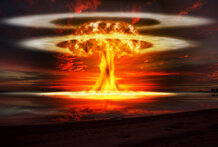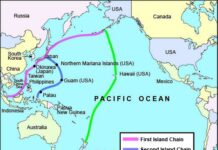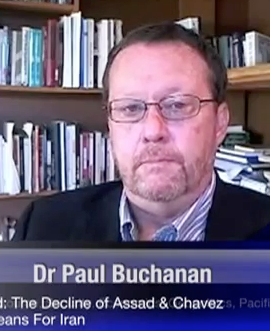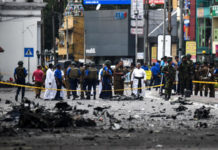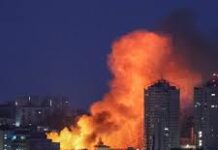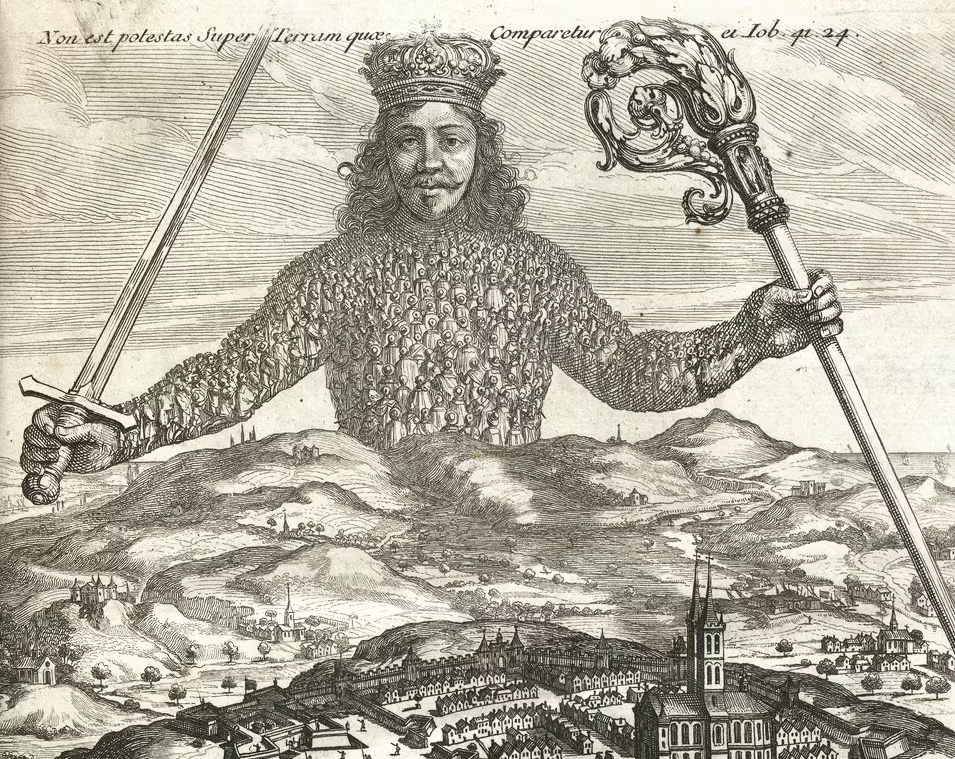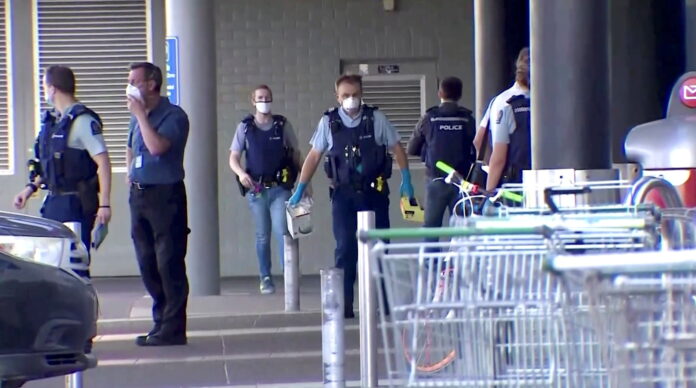
Director Paul G. Buchanan has researched and written for over thirty years about terrorism and irregular warfare. He has participated in counter-terrorism analysis and policy development while working in and with US government intelligence and military agencies, including leadership and recruitment profiling. With this background, he offers an assessment of the recent supermarket stabbings outside of Auckland, New Zealand.

Blood had not been mopped up from the floor after the supermarket stabbing spree when the prime minister strode to the parliamentary theatre podium and declared it to be an act of terrorism committed by an individual following an extremist ideology. Within minutes of her pronouncement the media sped to get reaction to the event. The terrorism studies industry dutifully jumped into action and joined the bandwagon labeling the stabbings as an act of terrorism committed by a “lone wolf,” followed by cheerleading the official line arguing that the powers of the State needed to be expanded so as to include acts of preparation and planning along with actual crimes of ideologically-motivated violence in the Terrorism Suppression Act (TSA). That several of the critically unreflective media-ordained “experts” who featured over the following days are associated with research centers that receive government (including security community) funding does not appear to have given a second of pause to the media booking agents (not that the funding of dedicated research centers is disqualifying but it should be acknowledged).
Allow me to present a contrary view, starting with some basic definitions of terrorism and its sub-types and then proceeding to a quick comparison between the Christchurch attacks of March 15, 2019 and what happened outside of Auckland on September 3, 2021.
There are several forms of terrorism. These include state terrorism (the most common form), where a State terrorizes its own people or other targets; state-sponsored terrorism, where a State uses a proxy to commit acts of terrorism against an enemy or its core interests (think of the Iranian relationship with Hamas or Hezbollah, or—dare I say it–the Saudi relationship with al-Qaeda); non-state terrorism, including criminal (for example, Mafia) and ideological terrorism perpetrated by non-state irregular warfare actors (al-Qaeda, Daesh, the IRA, Sendero Luminoso in Peru, Mano Blanca in El Salvador or “Triple A” in Argentina). The list is extensive and covers the entire ideological spectrum. The bottom line of non-state ideological terrorism is that it must have an explicitly political focus—it has a political end or endgame in mind.
There is also terrorism committed during war time and terrorism that occurs during peace. War terrorism is mainly a sub-set of state terrorism but is also found in irregular warfare. The fire-bombing of Dresden had little military purpose but was designed to have a psychological impact on the German population. Likewise, the nuclear bombings of Hiroshima and Nagasaki were done not so much because of the military importance of these targets but because of the psychological impact that a single bomb annihilation of a city would have on the Japanese. In both cases the purpose was to terrorize, not gain a military advantage per se. Likewise, beheadings and other atrocities committed by jihadists do not improve their military positions but do have a psychological impact on those who are witness or subject to them. Terrorism during peace are those that occur outside of recognized (declared or undeclared) conflicts. Again, this includes terrorism by the State against dissidents and criminal terrorism against authorities or non-compliant members of the public. As of 9/11, the focus has been on non-state ideological terrorism even if the specific ideology behind many acts of terrorism has shifted over time.
Terrorism can involve large-scale mass attacks or small cell and solo operator (“lone wolf”) attacks. The tactical logic at play is to commit acts of seemingly random and disproportionate violence against soft targets with the purpose of instilling fear, dread and a sense of powerlessness, if not hopelessness in the population. Be at the Bataclan in Paris or at a Labour Youth Camp in Norway, the terrorist seeks to atomise and infantilize the social subject so as to isolate and paralyze it in the face of the perpetrator’s actions. That facilitates surrender or acquiescence to the terrorist will.
Terrorism has a target, subject and an object. The target are the immediate victims of a terrorist act, the more vulnerable and helpless the better. The subject(s) is the wider audience, including the public, government and even sympathetic or like-minded groups and individuals. The object is to send a message and to bend the subject to the will of the perpetrator, that is, to get the subject(s) to do or not do something in accordance with the perpetrator’s objectives and desires.
Having said all of this, by way of illustration let us run a comparison between the Christchurch attacks and the supermarket stabbings.
The Christchurch killer meticulously planned over at least 18 months an act of mass murder, stockpiling weapons and ammunition in order to do so. He did so in secrecy and without drawing attention to his actions (or so the Royal Commission of Inquiry would like us to believe). He displayed cunning, situational awareness and observed operational security as he counted down to the attack date, which was chosen for its historical significance (the Ides of March). He wrote a lengthy manifesto detailing his ideological views and reasons for committing the attacks. As believers gathered in houses of worship on a day of prayer, his targets were highly symbolic and chosen after considerable observation and research. The acts of mass murder were carried out in a cold blooded, calculated, methodical manner, live streamed on social media and eagerly shared by his co-believers world-wide. After capture, he was determined to be sane if narcissistic in personality and interviews with those who knew him prior to March 15 said he exhibited no signs of mental illness. In fact, even though a foreigner, he had friends and socialised normally (I use the last term neutrally as opposed to differentiating between so-called “normal” and “abnormal” or “unusual” conduct).
Now consider the supermarket stabbings. By way of a broad summary, let’s note the following. The perpetrator—I will refer to him by his suppressed identity “Mr. S”– had been granted refugee status in NZ after leaving Sri Lanka in 2011 (he was Tamil) and yet for years had publicly spoken of his desire to kill infidels and his hatred of the West. He was said to be lonely and homesick, with few social contacts in NZ. After being arrested in 2015 he was assessed as being depressed, subject to wild mood swings, prone to violence as a result of having Post Traumatic Stress Disorder stemming from experiences as a Tamil in his homeland. He had come to the authorities’ attention by openly posting jihadist supportive rants online, making threats to others (including muslims) on social media, and for seemingly preparing to wage jihad in NZ or abroad. When searched his flat contained violent extremist literature and videos and hunting knives. After being arrested while trying to leave NZ on a one way ticket (which the authorities believe was to be a journey to the killing fields of Syria), he was bailed and promptly went out and bought an exact copy of a knife that had been confiscated from him, apparently from the same store that he had bought the first one. He was then re-arrested and charged with possessing an offensive weapon (charges later dropped) and with posessing objectionable materials in the form of jihadist literature and videos.
When in court he railed against the injustices done to him, threatened the judge and openly spoke about his desire to do harm to others. But, because his refugee status was being disputed, further cases against him were pending and he had served three years already while waiting for and then during trial, he was sentenced to community supervision for a year, then released on July 16 and bailed to a mosque that, as it turns out, did not have its own Imam but did have a bed. He was ordered to undergo psychiatric evaluation but refused to do so and was never forced to comply. Then came Friday Sept 3.
Rather then the culmination of months of meticulous planning and preparation, that day we saw a spontaneous act of white hot rage (which makes suggestions that strengthening the TSA to include acts of planning and preparation would have prevented the attack utterly ludicrous). He grabbed a knife off a shelf and started stabbing other shoppers (who, fortunately, were observing social distancing rules during the Level 4 pandemic lockdown). His targets were chosen opportunistically and at random–they were simply close enough to attack. He ran through the aisles yelling and shouting, thereby alerting other potential victims to impending danger. He ran from victim to victim rather than pause to finish them off in deliberate fashion. He had no manifesto and he he did not video his actions or communicate or transmit his attack to others. He had no subject other than his immediate targets and he had no object other than to satisfy his own bloodlust and sense of being wronged by society. His message was to himself.
He had no connections to any jihadist network because even if he once did (and that has not been alleged, much less proven) his internet access was cut off after his arrest and he was largely isolated within the Sri Lankan and Muslim communities because of his notoriety. He had no affective relationships to speak of since his family remains in Sri Lanka and he had no partner or romantic attachments. Described as normally behaved before he arrived in NZ, he descended into personal and political darkness in the years after, linking the two in his public and private utterances. In fact, although he glorified ISIS violence and fetishised bladed weapons, it is unclear how deeply rooted he was in the Salafist world view that underpins ISIS’s ideology.
After he was released in July he developed, according to media reports, an obsessive focus on someone whose identity is suppressed but who was deliberately distanced from him after concerns were raised about his behaviour towards that individual in the days before the stabbings. One can only wonder if this was a case of what is known as affective displacement or transfer in which his emotional focus shifted from jihad to something more immediate and personal, and when that object of attention was removed, he snapped. If so, his ideological focus was more an opportunistic product of his mental state than of true devotion to the extremist cause. Put another way, his homicidal ideation may not have primarily been driven by ideology, which may have been more of a convenient crutch for his grievances rather than the root cause of his sociopathy.
To be clear: I am no mental health expert and defer to them on the subject, but I have learned enough over the years to believe that something more than ideological zealotry may have been at play here.
What S did have is a constant armed police surveillance presence around him because unlike the judge who released him in the hope that he could be rehabilitated, the police had no illusions that he was anything but a danger to himself and society. They therefore devoted considerable resources to surreptitiously monitoring him. As it turns out, he received no rehabilitation as well, which meant that the police emphasis on covert surveillance from a distance was certainly not designed to be pre-emptive or preventative in nature (since an intensive rehab counselor could have given them daily updates on his state of mind). As quick as the police reaction was to the stabbings, they were at a disadvantage given the nature of their surveillance technique, which apparently did not benefit from regular psychological updates. This is no slight on the police. They did what they thought best given the difficult circumstances that they were put in, and in the end they saved lives.
Even lumping Mr. S with the Christchurch killer as “lone wolves” is problematic. The Christchurch killer clearly was such a threat, quietly stalking his prey and preparing his attacks. Mr. S, however, acted impulsively and without the type of deliberation usually associated with lone wolves. Rather than “flying under the radar” of specialised and dedicated counter-terrorism units in NZ (as the Royal Commission would like us to believe with regard to the Christchurch terrorist), he was a known, clear and present danger, at least as far as the police were concerned. Likening him to the March 15 killer as a lone wolf is , again, drawing too long a comparative bow. In fact Mr. S seems closer to the May Dunedin Countdown stabber (four wounded in that attack) than the Christchurch killer, even if the demons inside the Dunedin stabber’s head were fueled by meth rather than ideology and/or mental illness.
For those who would differentiate terrorism from other violent crimes by consequences or effects, here too Mr. S’s actions fall short of the definitional threshold. The Christchurch attacks had immediate and longer-term impacts at home and abroad. While championed by white supremacists and rightwing extremists and causing wide-spread fear in NZ society in the immediate aftermath, it had a more dramatic influence on counter-terrorism threat assessments and approaches world-wide. It occasioned considerable reflection within NZ about tolerance and community and has produced numerous government initiatives to address its root causes. Its message was heard globally, albeit in different ways by different audiences/subjects. In contrast, the supermarket attacks caused a media frenzy, some political debate, assorted commentary and much questioning of how S came to be loose in public. That focused scrutiny lasted about five days, but soon the story receded on media outlets and from the public eye, replaced by coverage of the lowering of Covid lock-down levels and the usual political and social news. Beyond the victims, immediate witnesses, some politicians, pundits, activists and police, NZ society is already moving on and the consequences of the attack outside of (and arguably even within) NZ is minimal. The Christchurch attacks had long-term and wide-ranging effect; the supermarket stabbing spree has had a relatively narrow and short term impact. In other words, in consequence it does not rise to the level of a terrorist attack.
Put another way. Although the supermarket stabbings were certainly terrifying to those who were in and around the store, they were not terroristic in intent or effect.
It is interesting to consider that Andrew Little is both the Minister of Health as well as the Minister of Intelligence and Security. While this may promote efficiency in the discharge of portfolio obligations, it meant that there was no ministerial cross-check on the decision about Mr. S. Instead it presented Mr. Little with a choice when it came to Mr. S: treat him as a mental health case or as a national security threat? The institutional bias underlying the decision about him given the portfolio arrangement is now clear. National security was the priority, not Mr. S’s mental health.
The government says that it considered ordering Mr. S into compulsory treatment under terms of the Mental Health (Compulsory Assessment and Treatment) Act, but was advised that it was not realistic to do so because he did not meet the threshold for involuntary commitment. This is presumably because even though he was diagnosed with PTSD, depression and other ailments, it did not rise to the level of a recognized clinically diagnosed disorder. Fair enough, because the bar for involuntary commitment must be set very high. But what about him being a clear and present danger to himself and society? Should that have factored into the decision as to whether he should be held for assessment and treatment? Had he not held ideological views, would have national security even entered into consideration even if the threat he presented to the public was the same? What would have been the decision then?
Because the decision was made against the mental health option, the government tried to revoke his refugee status so that he could be deported as a national security threat. That is easier said than done given international protocols governing the treatment of refugees, but what seems clear is that even though (or perhaps because) the High Court struck down prosecuting S under the Terrorism Suppression Act since “planning and preparation” is not part of the language in it, the Crown was determined to treat him as a jihadist rather than someone who was violently unwell. However coincidentally, Sept 5 fell into the government’s lap when it came to pushing under urgency amendments to the TSA that incorporated “planning and preparation” into the definition of behaviour covered by the Act, and the chorus of experts all sang in harmony the government line that the law, as it stands without the amendment, is unfit for purpose.
Three things should be noted as an aside. This is the second time that the Crown has attempted to invoke the TSA when no act of violence was committed, only to be rejected by the Court. The first was after the Urewera raids, when the not-so-merry band of activists and misfits were initially accused of being terrorists for playing Che Guevara in the bush. That attempt to lay charges under the TSA failed even though people were in fact terrorised: the innocent Tuhoe who were held at gunpoint (including children on a school bus) by Police. The second point is that even though the TSA does not allow for prosecutions for planning and preparing for a terrorist act, the Crimes Act has enough in it to do so. Just imagine if police had evidence of someone about to commit a “common” (non-ideologically motivated) murder. Would they not step in to prevent the deed by using the evidence collected under the Crimes Act? If so, what is the difference with an ideologically motivated crime that makes it only prosecutable under the TSA? As it turns out, the Crown went for six and tried to test the TSA a second time on Mr. S. And for the second time, it was given out by the Court.
The third point is that the government had a legal remedy on national security grounds that would have kept Mr. S confined indefinitely while being assessed and treated but chose not use it: issuing a Security Risk Certificate against him recommended by the Security Intelligence Service (SIS) and once used in the Ahmed Zaoui case (even though Zaoui never threatened or committed any act of violence). The Certificate calls for the preventative detention of an individual deemed to be a threat to NZ’s national security while legal processes are pending. Unlike Zaoui Mr. S was a well recognized threat to himself and others and yet, also unlike Zaoui, the Security Risk Certificate remedy was not explored or was rejected (perhaps because it too was “unreasonable” to do so). Which is odd given that he could have been subject to the strictures of the Security Risk Certificate during and after his trial regardless of sentence on lesser charges and therefore would not have been free on September 3 or required a constant resource-draining police surveillance presence in the weeks leading up to it. (Hat tip to Selwyn Manning for alerting me to this angle of inquiry).
In any event, rather than an act of terrorism or terrorist act (take your pick), what we saw on Sept. 5 was the commission of a hate crime. It is true that NZ does not have a hate crime statute and hate crimes are usually designated as acts of violence committed against individuals or groups because of who they are (e.g. gays, Muslims, redheads). Here the phrase “hate crime” is used because Mr. S’s hatred and rage was directed at non-Muslim society in general and because of the lack of compliance with the definitions and description of terrorism mentioned above. It does not make the supermarket attacks any less heinous than those done deliberately as terrorist attacks with the same (thankfully non-fatal) outcome. But it does help distinguish between underlying motive and rigorousness of method, which in turn helps prevent us from being suckered into agreeing and complying with the agendas of security officials and vested “experts” alike.





